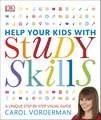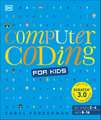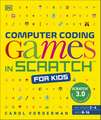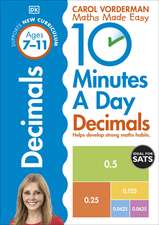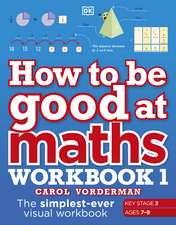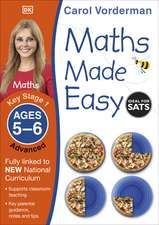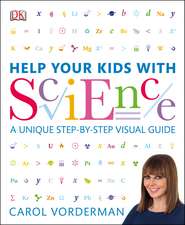Help Your Kids with English, Ages 10-16 (Key Stages 3-4): A Unique Step-by-Step Visual Guide, Revision and Reference: DK Help Your Kids With
Autor Carol Vordermanen Limba Engleză Paperback – 3 iun 2013
This visual reference book takes you through all the different parts of the English language, leaving you ready to help your children tackle the trickiest of subjects.
Carol Vorderman's unique study aid encourages parents and children to work together as a team to understand and use all aspects of the English language, including grammar, punctuation, and spelling. This latest title in the best-selling Help Your Kids series combines pictures, diagrams, instructions, and examples to cover the components of the school syllabus, while building knowledge, boosting confidence, and aiding understanding.
With your support, children can overcome the challenges of English, leaving them calm, confident, and exam ready.
Preț: 89.18 lei
Preț vechi: 100.60 lei
-11% Nou
Puncte Express: 134
Preț estimativ în valută:
17.07€ • 17.75$ • 14.09£
17.07€ • 17.75$ • 14.09£
Carte disponibilă
Livrare economică 27 martie-02 aprilie
Livrare express 07-13 martie pentru 54.39 lei
Preluare comenzi: 021 569.72.76
Specificații
ISBN-13: 9781409314943
ISBN-10: 1409314944
Pagini: 256
Ilustrații: Illustrations
Dimensiuni: 202 x 240 x 15 mm
Greutate: 0.8 kg
Editura: Dorling Kindersley - DK
Colecția DK
Seria DK Help Your Kids With
Locul publicării:London, United Kingdom
ISBN-10: 1409314944
Pagini: 256
Ilustrații: Illustrations
Dimensiuni: 202 x 240 x 15 mm
Greutate: 0.8 kg
Editura: Dorling Kindersley - DK
Colecția DK
Seria DK Help Your Kids With
Locul publicării:London, United Kingdom
Notă biografică
Carol Vorderman, one of Britain's best known and loved TV personalities, feels passionately about the value of education. Carol joined forces with DK in 1999 to become DK's Education Champion and has helped them to build the bestselling "Made Easy" series, which includes topics in maths, English, and science and technology. She has also encouraged parents and their teenage children to work together in the "Help Your Kids" series, which includes Help Your Kids With Maths and Help Your Kids With Music. Versatile as ever, Carol has also provided an accessible and fun entry into the world of computer programming with Computer Coding Projects For Kids.
Recenzii
The queen of numbers has turned her attention to words. Combining colourful diagrams and illustrations with step-by-step instructions, this makes English easier to fathom.
Cuprins
- 1: Foreword
- 2: Why learn the rules?
- 3: Spoken and written language
- 4: English around the world
- 5: Grammar
- 1: The purpose of grammar
- 2: Parts of speech
- 3: Nouns
- 4: Plurals
- 5: Adjectives
- 6: Comparatives and superlatives
- 7: Articles
- 8: Determiners
- 9: Pronouns
- 10: Number and gender
- 11: Verbs
- 12: Adverbs
- 13: Simple tenses
- 14: Perfect and continuous tenses
- 15: Participles
- 16: Auxiliary verbs
- 17: Irregular verbs
- 18: Verb agreement
- 19: Voices and moods
- 20: Phrasal verbs
- 21: Conjunctions
- 22: Prepositions
- 23: Interjections
- 24: Phrases
- 25: Clauses
- 26: Sentences
- 27: Compound sentences
- 28: Complex sentences
- 29: Using clauses correctly
- 30: Managing modifiers
- 31: Commonly misused words
- 32: Negatives
- 33: Relative clauses
- 34: Idioms, analogies and figures of speech
- 35: Colloquialisms and slang
- 36: Direct and indirect speech
- 6: Punctuation
- 1: What is punctuation?
- 2: Full stops and ellipses
- 3: Commas
- 4: Other uses of commas
- 5: Semi-colons
- 6: Colons
- 7: Apostrophes
- 8: Hyphens
- 9: Inverted commas
- 10: Question marks
- 11: Exclamation marks
- 12: Brackets and dashes
- 13: Bullet points
- 14: Numbers, dates and time
- 15: Other punctuation
- 16: Italics
- 7: Spelling
- 1: Why learn to spell?
- 2: Alphabetical order
- 3: Vowel sounds
- 4: Consonant sounds
- 5: Syllables
- 6: Morphemes
- 7: Understanding English irregularities
- 8: Roots
- 9: Prefixes and suffixes
- 10: Hard and soft letter sounds
- 11: Words ending in -e or -y
- 12: Words ending in -tion, -sion or -ssion
- 13: Words ending in -able or -ible
- 14: Words ending in -le, -el, -al or -ol
- 15: Single and double consonant words
- 16: The “i before e except after c” rule
- 17: Capital letters
- 18: Silent letters
- 19: Compound words
- 20: Irregular word spellings
- 21: Homonyms, homophones and homographs
- 22: Confusing words
- 23: Other confusing words
- 24: Abbreviations
- 25: British and American spellings
- 26: More British and American spellings
- 8: Communication skills
- 1: Effective communication
- 2: Picking the right words
- 3: Making sentences interesting
- 4: Planning and research
- 5: Paragraphing
- 6: Genre, purpose and audience
- 7: Reading and commenting on texts
- 8: Layout and presentational features
- 9: Writing to inform
- 10: Newspaper articles
- 11: Letters and e-mails
- 12: Writing to influence
- 13: Writing to explain or advise
- 14: Writing to analyse or review
- 15: Writing to describe
- 16: Writing from personal experience
- 17: Writing a narrative
- 18: Writing for the Web
- 19: Writing a script
- 20: Re-creations
- 21: Checking and editing
- 22: The spoken word
- 23: Debates and role plays
- 24: Writing a speech
- 25: Presentation skills
- 8: Reference
- 1: Reference - Grammar
- 2: Reference - Punctuation
- 3: Reference - Spelling
- 4: Reference - Communication skills
- 5: Glossary
- 6: Index
- 7: Acknowledgements

